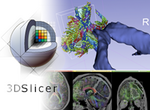Difference between revisions of "Projects:RegistrationDocumentation:UseCaseInventory:BrainIntraDTI"
From NAMIC Wiki
| Line 3: | Line 3: | ||
The most common task in Diffusion MRI registration is aligning an anatomical reference with the tensor data or fiber-tracts derived from DTI. Because the DTI is tensor data, applying a spatial transform to this image is not trivial. Hence a common approach is to align the anatomical reference (such as a T1 MRI) to the DTI image and thus avoid having to resample the tensor. This, however, preserves the strong distortions often present in the DTI image and makes anatomical referencing difficult. | The most common task in Diffusion MRI registration is aligning an anatomical reference with the tensor data or fiber-tracts derived from DTI. Because the DTI is tensor data, applying a spatial transform to this image is not trivial. Hence a common approach is to align the anatomical reference (such as a T1 MRI) to the DTI image and thus avoid having to resample the tensor. This, however, preserves the strong distortions often present in the DTI image and makes anatomical referencing difficult. | ||
| − | *[[Image:RegLib_C03_Baseline_axial.png|70px|lleft|RegLib 03: DTI alignment]] [[Image:RegLib_C03_DTIVol_axial.png|70px|lleft|RegLib C03: DTI alignment]] | + | *[[Image:RegLib_C03_Baseline_axial.png|70px|lleft|RegLib 03: DTI alignment]] [[Image:RegLib_C03_DTIVol_axial.png|70px|lleft|RegLib C03: DTI alignment]] [[Image:Slicer4_RegLibLogo.png|150px|verified/updated for Slicer 4.1]] '''Case 03: [[Projects:RegistrationLibrary:RegLib_C03|DWI alignment: align DTI volume with T2 structural reference scan]]''' |
| + | *[[Image:RegLib_C03_Baseline_axial.png|70px|lleft|RegLib 03: DTI alignment]] [[Image:RegLib_C03_DTIVol_axial.png|70px|lleft|RegLib C03: DTI alignment]] Case 03B: [[Projects:RegistrationLibrary:RegLib_C03B|DWI alignment + '''preprocessing''']] | ||
*[[Image:RegLib27_FLAIR.png|70px|lleft|RegLib C27 FLAIR]] [[Image:RegLib27_DTI.png|70px|lleft|RegLib C27 DTI]] [[Image:Slicer3-6Announcement-v1.png|70px|This case is complete and up to date for version 3.6.1]]'''Case 27: [[Projects:RegistrationLibrary:RegLib_C27|DTI baseline to FLAIR/T1 pair, large pathol.]]''' | *[[Image:RegLib27_FLAIR.png|70px|lleft|RegLib C27 FLAIR]] [[Image:RegLib27_DTI.png|70px|lleft|RegLib C27 DTI]] [[Image:Slicer3-6Announcement-v1.png|70px|This case is complete and up to date for version 3.6.1]]'''Case 27: [[Projects:RegistrationLibrary:RegLib_C27|DTI baseline to FLAIR/T1 pair, large pathol.]]''' | ||
*[[Image:RegLib_C29_Thumb.png|140px|lleft|RegLib C29]] [[Image:Slicer3-6Announcement-v1.png|70px|This case is complete and up to date for version 3.6.1]] '''Case 29: [[Projects:RegistrationLibrary:RegLib_C29|DTI to T1]] ''' / <small> Alignment of DTI and fMRI scan to structural reference T2/T1 pair for surgical planning (tumor resection)</small> | *[[Image:RegLib_C29_Thumb.png|140px|lleft|RegLib C29]] [[Image:Slicer3-6Announcement-v1.png|70px|This case is complete and up to date for version 3.6.1]] '''Case 29: [[Projects:RegistrationLibrary:RegLib_C29|DTI to T1]] ''' / <small> Alignment of DTI and fMRI scan to structural reference T2/T1 pair for surgical planning (tumor resection)</small> | ||
Revision as of 19:56, 4 May 2012
Home < Projects:RegistrationDocumentation:UseCaseInventory:BrainIntraDTICase Inventory DTI
The most common task in Diffusion MRI registration is aligning an anatomical reference with the tensor data or fiber-tracts derived from DTI. Because the DTI is tensor data, applying a spatial transform to this image is not trivial. Hence a common approach is to align the anatomical reference (such as a T1 MRI) to the DTI image and thus avoid having to resample the tensor. This, however, preserves the strong distortions often present in the DTI image and makes anatomical referencing difficult.


 Case 03: DWI alignment: align DTI volume with T2 structural reference scan
Case 03: DWI alignment: align DTI volume with T2 structural reference scan
 Case 03B: DWI alignment + preprocessing
Case 03B: DWI alignment + preprocessing

 Case 27: DTI baseline to FLAIR/T1 pair, large pathol.
Case 27: DTI baseline to FLAIR/T1 pair, large pathol.
 Case 29: DTI to T1 / Alignment of DTI and fMRI scan to structural reference T2/T1 pair for surgical planning (tumor resection)
Case 29: DTI to T1 / Alignment of DTI and fMRI scan to structural reference T2/T1 pair for surgical planning (tumor resection)

 Case 30: lowres & small FOV DTI to T1, no T2
Case 30: lowres & small FOV DTI to T1, no T2

 Case 32: inverse direction: T1 to DTI
Case 32: inverse direction: T1 to DTI 

 Case 33: DTI baseline to T1, incl. pathol.
Case 33: DTI baseline to T1, incl. pathol.